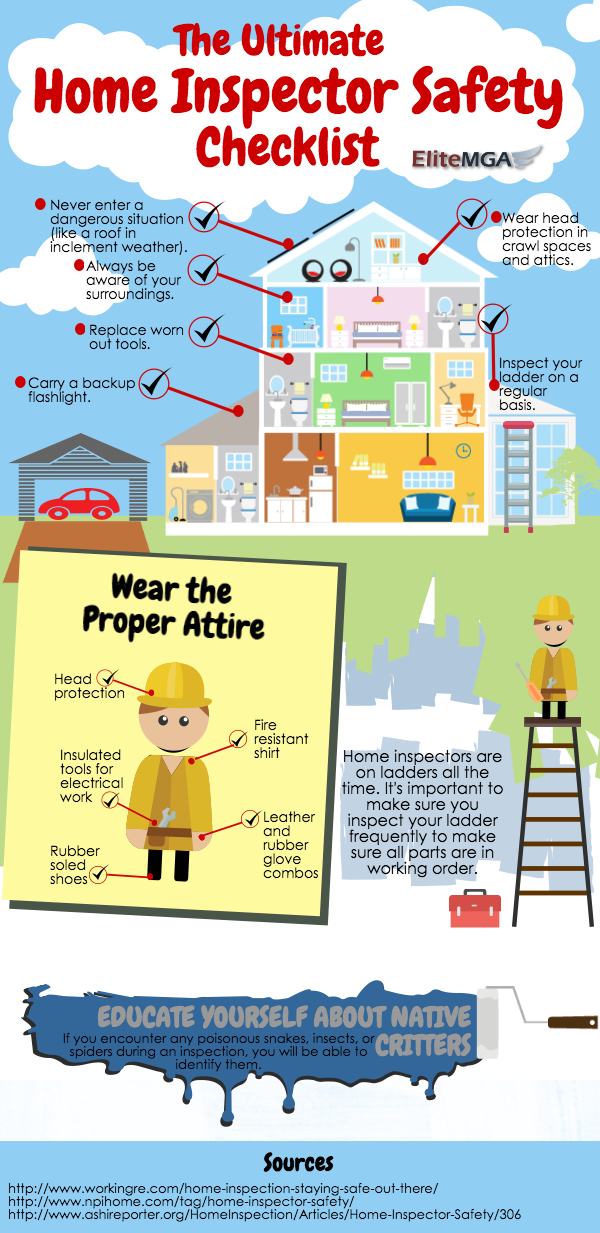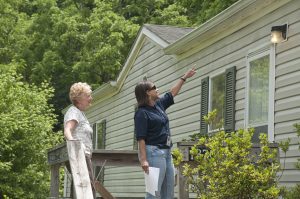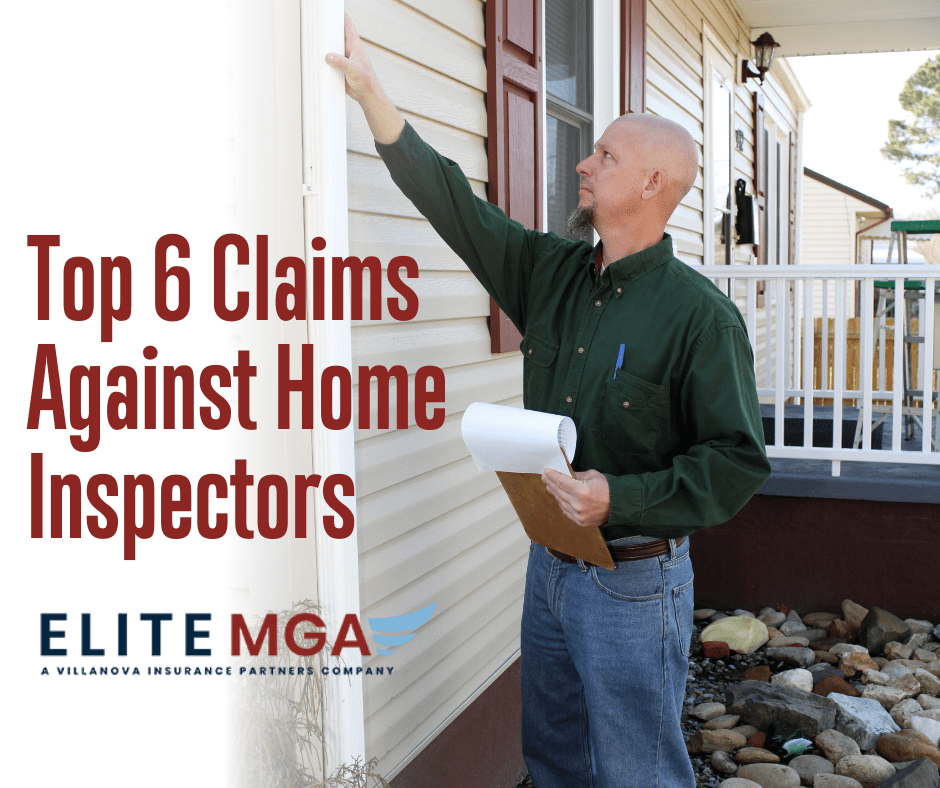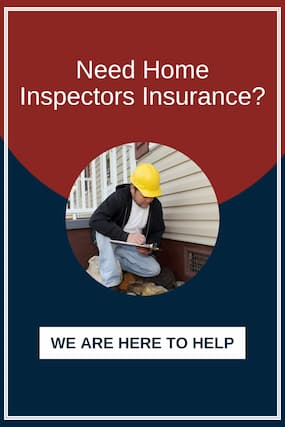Home inspectors are expected to put themselves into all kinds of dangerous situations when inspecting a home, many of which are unpredictable. Between crawl spaces, attics, rooftops, and the possibility of run-ins with dangerous critters, the home inspecting job by nature is a relatively risky one. However, all too often safety during home inspections is overlooked not only during training but also on the day to day job.
Safety Tips for Home Inspectors
As a home inspector, it’s important to know what precautions to take when you’re working to keep yourself safe. The following tips can help you protect yourself, which is especially important when most of your job deals with unknowns.
- Never enter a dangerous situation like a roof in inclement weather
- Always wear head protection in crawl spaces and attics
- Replace old or worn out tools
- Carry a backup flashlight
- Always be aware of your surroundings
- Inspect your ladder on a regular basis -Home inspectors are on ladders all the time, so it’s important that all parts are in working order.
- Educate yourself on native critters in case you encounter poisonous snakes, insects, or spiders during an inspection
- Wear the proper attire
- Head protection
- Fire resistant shirts
- Insulated tools for electrical work
- Rubber-soled shoes
- Leather and rubber gloves combos
Safety Equipments & Tools Every Home Inspector Must Have
Home inspectors face a broad and varied number of needs in terms of performing a thorough home inspection. It is true that currently, there are no industry-wide mandated items that they must have to perform their job safely and thoroughly from a physical and legal standpoint. The existing truth that trumps that reality is that the more prepared they are in terms of items for accurate measurement and inspection as well as versatility of safety and access, the more effective they will be at their job. What follows is a general breakdown of home inspection tools as well as other tools for professional safety such as E&O insurance that are crucial to performance, effectiveness, and safety on the job.
How to Prepare for Dangerous & Hazardous Conditions During a Home Inspection?
- Gloves, safety glasses, boots, and a sturdy, practical ladder are a must for any inspector. So too are heavy duty protective gloves as well as electrical gloves.
- The electrical gloves should meet ASTM D-120/EIC903 specifications and have high dielectric and physical strength. They typically consist of liner gloves under rubber insulating gloves, with protective leather gloves worn over these.
- High-traction roof boots with replaceable soles make it easier for inspectors to walk roofs without slipping.
- Although a significant number of home inspectors still utilize conventional ladders, many inspectors utilize telescoping ladders for ease of carrying for roof access and some internal areas.
- A toolkit that includes binoculars, steel tape measure, ¼” and 5/16” nut driver, and a four-way screwdriver often comes in handy.
- Other items for the toolkit include telescoping magnets for retrieving screws, electrician’s knife, compass, night-light, spare batteries and bulbs, and carpenter’s level may also be included.
- A smoke pen to see air movement when checking combustion appliances for back-drafting of toxic exhaust gases as well as to ensure return-air vents are operating properly is also a handy toolkit addition.
- Telescoping adjustable mirrors for looking into areas where accessibility is limited and a flame mirror to inspect the interiors of oil burners are important additions as well.
- Having a tool vest provides portability to carry things like the flashlight, a moisture meter, infrared thermometer, electrical testers, cell phone, and a mirror among other commonly needed items.
- High-quality disposable dust masks can protect against dust and other contaminants such as insulation particles that may get into the lungs.
- In addition, inspectors should have a respirator for the times when they must enter areas containing materials that represent biological hazards. These can include viral, bacterial and fungal organisms that can lodge in the respiratory system as well as asbestos and other carcinogens.
- As to important meters for the inspector, they include a multimeter to detect live electrical circuits of voltage present (even if no current is flowing), as well as carbon monoxide analyzer to test for the gas emanating from water heaters, furnaces, and boilers.
- Also, a portable combustible gas leak detector permits checking for toxic gas leaks in the gas line.
An analog or digital metal shaft thermometer comes in handy to measure the temperature differential in cooling and heating systems. - Other important analyzers used by inspectors are moisture meters and infrared cameras.
- Moisture meters can quantify the percentage of moisture content in wood and non-wood products or to track down roof and plumbing leaks, and missing insulation, and assess the home’s overall energy efficiency.
- Infrared thermometers are used for checking the temperature of heating and cooling equipment, including registers, hot water, etc., and the temperature of electrical equipment, such as circuit breakers.
In addition to home inspection tools that allow a thorough and safe home inspection, it is imperative that a home inspector has the tools that protect his business as well. Errors & Omissions, which is commonly referred to as E&O insurance, provides the home inspector with coverage that mitigates any financial loss that may come from being held legally responsible for financial losses someone may incur because of something the inspector failed to find or report in the course of the inspection.
Tips to Avoid Home Inspection Electrocution
Electrical problems are the largest cause of home fires, and home inspectors must be diligent about inspecting wiring. And, when missing one faulty wire during an inspection can lead to legal and financial repercussions, home inspectors need E & O insurance protection. The home inspectors we insure are often elbow-deep in faulty wiring, and we felt it important to present some basic tips and precautions to avoid home inspection electrocution.
Where do the Dangers lie?
Some of the most common wiring problems found during a typical home inspection include –
- Worn out or improperly wired grounded receptacles,
- Loose, hanging wiring, and
- Open junction boxes
- In addition, it is common to find wiring under joists or connections not in boxes, inadequately sized wiring and/or switches (which means not heavy enough to handle the load), oversized fuses or even circuit breakers.
While Ground Fault Circuit Interrupter (GFCIs) are required in all new construction for exterior, garage, basement, bathroom and kitchen circuits, ideally they should be retrofitted into all existing homes. Although industry standards require that home inspectors test a “representative sample” of outlets, switches, and light fixtures, it is best to check every one for proper position and spacing during an inspection.
Where are the Risks for Electrocution during a Home Inspection?
OSHA and other sources stress that you can get a painful shock and potential muscle control loss for contact with a circuit generating 6–25 milliamperes (mA). The reality is that any power source capable of supplying more than 30mA has the potential to kill you regardless of voltage. Consequently, there are some basic procedures to follow when working with electrical equipment during a home inspection.
Tips and Precautions to Avoid Electrocution During Home Inspections
- Turn Off Power: The first step in the electrical circuitry portion of a home inspection is to turn off the power to electrical circuits before inspection and then test the circuits with your multimeter to ensure that the power is off.
- Stay 10 Feet Away From Power Lines: Even during roof inspections, home inspectors encounter dangers of electricity such as with overhead power lines or the electrical drop from the power line pole. It’s recommended that you stay at least ten feet or more from them to avoid possible electrocution even as you visually inspect the drop for fraying or other electrical hazards.
- “Safe” Voltages Can Still Be Dangerous: Attic inspections can also pose some electrical risks as they may bring inspectors into close contact with open circuits or faulty wiring. It is wise to remember that even “safe” voltages can be dangerous, so receiving even a mild shock when you are on a roof can cause you to lose your balance.
- Wear PPE: Some ways to prevent these accidents are through the use of insulation, guarding, grounding, electrical protective devices and clothing as well as safe work practices. It is recommended that all home inspectors wear electrical gloves that meet ASTM D-120/EIC903 specifications. Electrical gloves should have high dielectric and physical strength. They typically consist of liner gloves under rubber insulating gloves, with protective leather gloves worn over these. Always wear insulated shoes when inspecting any electric circuitry or receptacles. Although it is common sense to avoid working in areas that combine water and electrical circuits, if that cannot be avoided, wear rubber boots and gloves to lessen your chance of getting shocked.
- Insulate Tools: When utilizing any tools during a home inspection, be sure that they have proper insulation. Insulators such as glass, mica, rubber, or plastic used to coat metals and other conductors help stop or reduce the flow of electrical current. This helps prevent shock, fires, and short circuits.
- Use Electrical Testers: Inspectors should be armed with a variety of electrical testers such as a high quality tester for testing ground-fault circuit interrupter (GFCI) devices. Ideally the home inspector should be armed with the best and most versatile electrical tester that they can afford. This is typically classified as a tester that checks for proper operation of arc-fault and ground-fault circuit interrupter devices (AFCI/GFCI tester). This is in addition to the ability to test for the presence of 120-volt and 240-volt electrical current.
Protect Yourself with Home Inspector E&O Insurance
All of these precautions work to provide physical and legal protection for the home inspector so that they can avoid unsafe conditions that can come back to haunt them. Spending time, money, and effort to improve safety precautions can not only save your business money but could also save your life. While home inspectors must be willing to explore unfamiliar territories, it should be done with the utmost care and safety. In addition to these safety tips while on the job, another great way to protect yourself as a home inspector is to invest in home inspector errors & omissions insurance.
E&O insurance can protect your finances in case of a missed issue during an inspection that leads to a lawsuit. In addition to home inspection E&O insurance coverage, home inspectors are best served by also having General Liability insurance. This provides them with coverage if damage occurs to the home or someone is physically harmed at the home due to some type of negligence by the inspector, such as a falling ladder.
For more questions about how you can protect yourself as a home inspector, contact us at EliteMGA!





